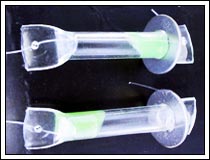Water Pasteurization Indicator
Water Pasteurization Indicators or WAPIs are a type of simple and low-cost thermometers that indicate when water or milk has reached their pasteurization temperature. Invented by Fred Barrett and Dale Andreatta, these reusable device contains a special soy wax that melts at the same temperature as the water is  pasteurized, thus indicating that the water has reached its pasteurization temperature and is safe for drinking. pasteurized, thus indicating that the water has reached its pasteurization temperature and is safe for drinking.
Before understanding about WAPIs, we need to know a bit about the process of pasteurization. Pasteurization refers to a process of heating liquid edibles or drinking water, to a specific temperature for a definite length of time and then cooling it immediately to disinfect it from microbes, including E Coli, Rotaviruses; Giardia and Hepatitis A virus. Unlike sterilization, this process aims to reduce the number of viable pathogens or slower the growth of microbes so that they are unlikely to cause diseases. Mostly, solar cookers are used to pasteurize water.
Although there are an impressive variety of WAPIs available commercially in varying sizes and shapes, all of them are fabricated in the same manner and also work on the same principle. Ideally, it is a simple polycarbonate tube containing a special soy wax that melts at 65oC/149˚F, which is the pasteurization temperature of water. In the process, the WAPI is placed washer down and wax up inside the water with the end of the string outside of the pot or jar. The end with the washer should rest on the bottom of the pot or jar and the wax end should be higher. When water in the cooker reaches its pasteurization temperature, the wax in the WAPI melts and falls to the bottom.
WAPIs works specially well in solar cookers, but they are also compatible with other fuel sources including wood, charcoal and gas. With good sun, simple solar cookers can pasteurize water for a family at a rate of about one liter of water per hour.
|